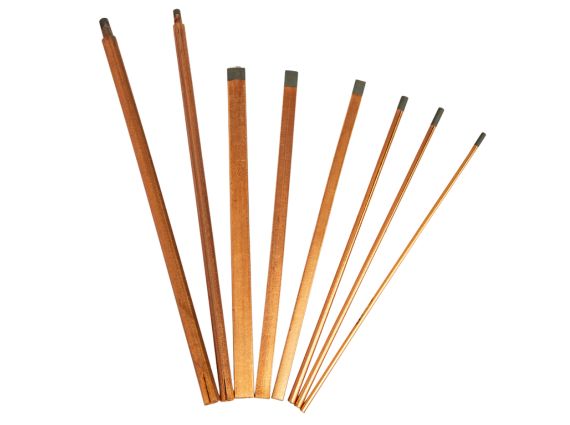Why do we need to add copper plating or other metal coatings? How can we optimize the coating process?
The main reasons for adding copper plating or other metal coatings to carbon rods are as follows:
Improving conductivity: Copper and other metals have good conductivity. Adding copper plating to the surface of carbon rods can reduce contact resistance, make current transmission more efficient, and reduce power loss. For example, in some electrode applications, it can improve the conductivity of the electrode and ensure the smooth progress of electrochemical reactions.
Enhancing oxidation resistance: Carbon rods are easily oxidized at high temperatures or in specific environments. Metal coatings can serve as a protective layer to isolate carbon rods from oxidizing substances such as oxygen, improve the oxidation resistance of carbon rods, and extend their service life. For example, in the heating elements of some high-temperature furnaces, it can prevent carbon rods from being damaged by oxidation too quickly.
Improving mechanical properties: Metal coatings can increase the hardness and wear resistance of the carbon rod surface, making it more resistant to wear and impact, improving the mechanical strength of the carbon rod, and reducing the possibility of damage and breakage during use. For example, in some occasions that require frequent movement or vibration, it can enhance the reliability of carbon rods.
Here are some ways to optimize the coating process:
Pretreatment process optimization
Surface cleaning: Before applying the metal coating, the surface of the carbon rod needs to be thoroughly cleaned to remove oil, dust, impurities, etc. to improve the adhesion of the coating to the carbon rod surface. Chemical cleaning, ultrasonic cleaning and other methods can be used.
Surface roughening: The surface of the carbon rod is roughened by mechanical grinding, chemical corrosion and other methods to increase the surface roughness and increase the contact area between the coating and the carbon rod, thereby improving the adhesion of the coating. For example, the surface of the carbon rod is polished with sandpaper, or chemical methods such as acid etching are used to form a microscopic concave-convex structure on the surface.
Coating process optimization
Electroplating process optimization: If electroplating is used to apply copper plating or other metal coatings, the composition, concentration, temperature, pH value of the plating solution, as well as the electroplating current density, time and other parameters need to be precisely controlled. For example, by adjusting the concentration of copper ions in the plating solution and the electroplating current density, the growth rate and quality of the copper plating can be controlled to obtain a uniform and dense coating.
Chemical plating process optimization: For chemical plating, it is necessary to optimize the formulation of the plating solution, including the selection and concentration control of reducing agents, complexing agents, catalysts and other components, and control the reaction temperature and time. For example, the selection of appropriate reducing agents and complexing agents can make metal ions uniformly reduced and deposited on the surface of the carbon rod to form a good coating.
Physical vapor deposition (PVD) process optimization: When using the PVD process, it is necessary to control the vacuum degree of the coating, the temperature of the evaporation source, the deposition rate and other parameters. For example, by accurately controlling the temperature and deposition rate of the evaporation source, metal atoms can be uniformly deposited on the surface of the carbon rod to form a high-quality coating.
Chemical vapor deposition (CVD) process optimization: For the CVD process, it is necessary to optimize the parameters such as the type, flow rate, pressure and reaction temperature of the reaction gas. For example, by selecting the appropriate reaction gas and controlling its flow rate ratio, a metal coating with good performance can be deposited on the surface of the carbon rod.
Post-processing process optimization
Heat treatment: Appropriate heat treatment of the coated carbon rod can improve the structure and performance of the coating and improve the bonding between the coating and the carbon rod. For example, annealing treatment is performed at a certain temperature to eliminate the internal stress of the coating, making the coating denser and more stable.
Coating inspection and quality control: Advanced inspection technologies such as metallographic microscope, scanning electron microscope (SEM), energy spectrum analysis (EDS), etc. are used to inspect and analyze the thickness, uniformity, composition, and organizational structure of the coating, and timely discover problems with the coating and make adjustments. At the same time, a strict quality control system is established to conduct random inspections on each batch of coated products to ensure that the coating quality meets the requirements.

Contact: admin
Phone: +86-13665233012
E-mail: service@weldmaterial.com
Add: Huanghua Industrial park, Jiangdu City, Yangzhou , Jiangsu Provicne, China.